John Wolff's Web Museum
The Canon SE-600 Programmable Calculator
Contents
|
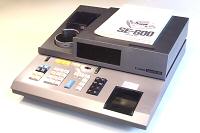
|
Canon "Canola" Model SE-600, S/N 400058
Functions: ASMD, square root, 100 memories
Programming: 600 steps, subroutines, punched card entry
Technology: Bipolar DTL/TTL on 14 boards
Display: 3 digit program counter, 16+5 digit printer
Dimensions: 405W x 530D x 190H, weight 21.5kg
Manufactured: Canon, Japan, 1971
|
Overview
The Canola SE-600 programmable calculator from 1971 probably
represents the ultimate development of the second-generation
DTL-SSI calculator technology.
As a keyboard-driven desk calculator, the SE-600 is little more
than a basic 4-function machine with square root and two memory
registers. It has an internal dot-matrix printer which records all
entries, operations, and results, but there is no immediate numeric
display.
As a programmable machine, its power comes from its computer-like
ability to execute conditional branching and nested subroutines, and
from its enormous (for the time) complement of one hundred memory
registers, each capable of holding a 16-digit BCD number or 6
program steps.
Programming the SE-600 is carried out off-line by flowcharting and
mnemonic coding, followed by hand-assembly into numeric opcodes and
addresses, and manual transfer into BCD or binary form on pre-perforated
IBM cards. Multiple programs or sub-routines can then be loaded into
memory through the internal card reader and executed from the keyboard.
Although it has no inbuilt mathematical functions, the calculator was
supplied with extensive subroutine libraries on punched cards. These
included trig and hyperbolic functions in degrees and radians, Bessel
functions, logs and exponentials, powers and roots, complex numbers,
and coordinate transformations.
Additional program libraries for the SE-600 were developed and sold
by third parties. The machine illustrated was originally used in a
surveyor's office, and has an extensive library of survey calculations
on punched cards. The programs were developed by a firm of engineering
consultants in Melbourne, "with the assistance of many surveyors
throughout Australia".
The circuitry of the SE-600 uses almost 400 DTL ICs from the
standard Texas Instruments families, with a small number of TTL
and "special" chips. The mechanical delay-line memory of the earlier
machines has been replaced with a solid-state version using
Intel 1404 1024-bit MOS shift registers. The machine runs from a
2-phase clock at 1.3MHz, and calculates a square root in around 40mS.
Construction and circuitry
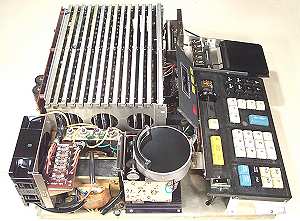 General arrangement
General arrangement
The calculator is constructed on a pressed and welded steel
baseplate about 450mm (18") square and 2mm thick. The outer cabinet
is mainly aluminium, and is built up in four separate layers. There
are double-skin panels, corner gussets, and extensive welded joints.
The keyboard escutcheon panel is 3mm aluminium, and the front panel
is a full 4mm thick. It takes 26 screws to disassemble the case.
The 14 double-sided circuit boards are mounted vertically in
the card cage at the rear of the machine. The power supply board is
screwed to the back of the card cage. The punched card reader is at
the front right of the machine. In the foreground (ie, on the left
of the machine) are the cooling fan, fuse panel, transformer, main
rectifier, and the printer. The keyboard uses glass reed switches
operated by moving magnets attached to the bottoms of the keys. The
space under the keyboard is empty.
The power supply produces +200, +15, +9, +5, -5, -15, -23, and -100
volts DC from five separate windings on the main transformer. The
mains input can be wired for 110/120/220/240VAC and is rated at 78W.
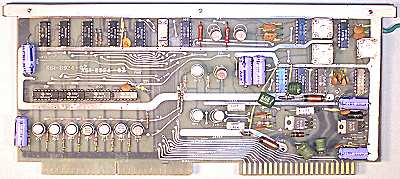 Circuit boards
Circuit boards
The SE-600 is built on a set of 14 double-sided circuit boards, each
with a component area of 280 x 120mm (11" x 4-3/4"). Each board has
a 2x28 and a 2x22-way edge connector, which plug into the horizontal
backplane. The keyboard, printer, and card reader also plug in to
sockets on the backplane.
The processor circuitry is built primarily from 14-pin SSI ICs from
the Texas Instruments SN39xx, 45xx, and 158xx DTL series. There are a
few chips from the (then-new) SN74xx TTL series, and a small number of
Intel and Toshiba chips. In total, there are around 385 separate chips
on the 14 boards. There are about 360 diodes, and 60 discrete
transistors.
Board 14 (illustrated) at the rear of the card cage carries the master
clock generator and the solid-state delay-line memory. (Canon's earlier
calculators used mechanical (ie, acoustic) delay line memories). The
memory is organised as one hundred 72-bit words, and is implemented
using seven Intel 1404 1024-stage dynamic shift registers in the
metal-can packages at the lower left. Readers will observe that 7 x 1024
is only 7168 bits - the missing 32 bits were provided by adding two 7491
8-stage TTL shift registers to each end of the 1404 (MOS) chain. These
chips are located directly above the 1404s. The two-phase master clock
is generated by the DTL/TTL chips and 3 trimmer capacitors at the upper
right, and is buffered by a 7440 and the 6 metal-can transistors in the
centre of the board. The clock runs at around 1.3MHz, giving a memory
cycle time of about 5mS for the 7,200 bits. At the lower right are
on-board +5V and -10V regulators and filters to isolate the memory from
the main power supplies.
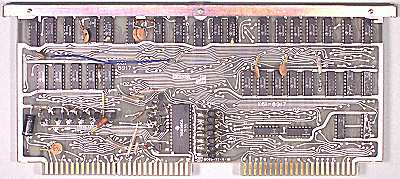 Board 7
Board 7
Board 7 shows the typical chip and track density on the remaining
boards, and contains the only large-package device in the machine - a
Texas Instruments TMS-4134-NC MOS-LSI chip in a 28-pin package. The MOS
device is interfaced to the DTL logic levels with a set of 18
discrete-transistor drivers.
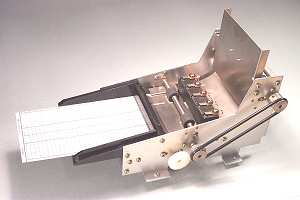 The card reader mechanism.
The card reader mechanism.
The optical reader for the IBM-standard punched cards is located at
the front right-hand corner of the machine, with the card entry tray set
into the keyboard escutcheon. The card is illuminated from above by
five miniature incandescent lamps in the assembly just behind the feed
roller, and the 12-channel photocell assembly is in the corresponding
position underneath. The face of the card is printed with bit values
to assist in coding, while the back is blackened to reduce reflections
in the read head.
The cards are fed in one at a time by hand, and are drawn through
by a DC motor and ejected vertically into a small hopper. The motor
and lamps are controlled directly by microswitches on the infeed and
outfeed chutes. Each card takes about 3 seconds to pass through
the reader.
A circuit board mounted under the reader contains the 12 photocell
amplifiers, along with data latches and synchronising circuits.
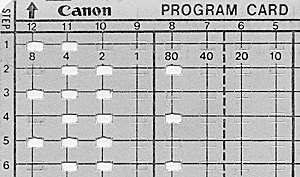 Pre-punched card detail.
Pre-punched card detail.
The SE-600 uses 40-column pre-perforated cards that are intended to be
prepared by hand. The cards are the same size (3-1/4" x 7-3/8") and
have the same punch spacings as the standard 80-column cards, except
that every odd-numbered column is omitted (ie, column n on the Canon
card is in position 2n on the standard card).
The illustration shows a small portion of a program card with the
pre-perforated punch outlines clearly visible on the printed grid. The
calculator user could simply press out the chads with a suitable tool
in the positions where a hole was required.
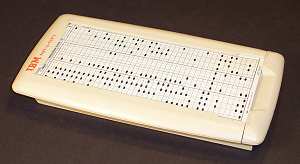 The portable card punch.
The portable card punch.
The more serious programmers from the 1960s would most likely
have been equipped with a device like this IBM "Port-a-Punch".
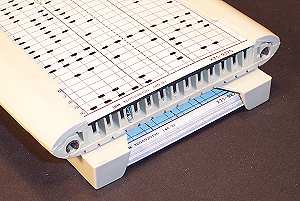 IBM Port-a-Punch detail.
IBM Port-a-Punch detail.
The "Port-a-Punch" holds the card securely around the edges and
supports it on a series of lengthwise rubber strips, allowing the
chads to be pressed through into the channels below. The end cover
can be removed to empty the remains. A tray in the base of the unit
holds a supply of blank cards ready for punching.
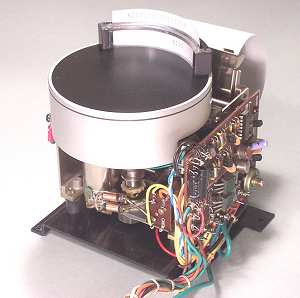 The printer mechanism.
The printer mechanism.
The rotary dot-matrix printer mechanism is about 115mm square and
150mm high, and is located near the front left corner of the machine.
It prints about 4 lines per inch, and 3 lines per second, on 70mm
"electro-sensitive" paper.
The paper is coated with a layer of carbon and covered by a thin
aluminised film, giving it a silver-grey appearance. As the printer
pins sweep across the film they are fed with short 100-volt pulses,
which vaporise the aluminium layer and allow a black dot of carbon
to show through.
The small circuit board contains only the motor and clutch drivers,
the pin driver, and the synchronising circuits. The control logic
and character generation circuits are in the main card cage.
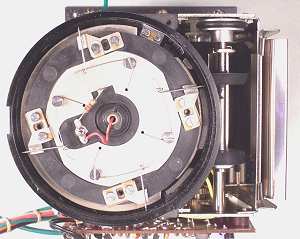 The print head and paper transport.
The print head and paper transport.
The printer mechanism uses a rotary print head about 75mm in
diameter, with four single pins attached at 90° intervals in the
same horizontal plane. The head is driven at a nominal 600RPM by a
small DC motor. A slotted disk and two photocells provide timing
signals to synchronise the start of each pin scan and the start of
each character position, ensuring that the character spacing remains
constant even if the motor speed varies.
The paper transport is geared directly to the rotation of the print
head, thus setting the spacing between the scan lines (and resulting in
a slightly helical scan). Specially shaped guides and tapered rollers
are used to form the paper into a precise circular arc.
A dynamic brake on the motor brings the mechanism quickly to a halt
on completion of printing.
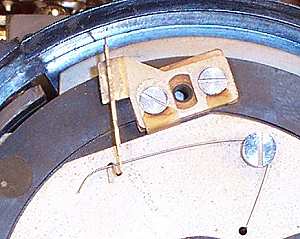 The printer pins.
The printer pins.
The printer pins are located in tiny tubular guides attached to
screwed brackets on the rotating disk, and are held forward against the
paper by the even tinier hairsprings. A collar prevents the pins moving
too far forward after they have passed the trailing edge of the paper.
The printer generates 5x7 characters in an 11x15 matrix, with two
scan lines above and below used for thousands separators and decimal
points. There are 16 numeral positions and 5 symbol positions, giving
a total of 231 dots per line. At 600RPM, each pin has 25mS to complete
a scan, requiring a dot clock rate of about 9kHz. The drive pulses
for each dot are -100VDC and about 90μS duration.
 Sample printout.
Sample printout.
This sample printout shows 16-digit precision, thousands separators,
and floating decimal points. The annotations to the right mean that
the buffer register B was transferred to memories 01 and 02.
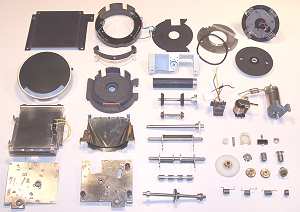 Printer parts.
Printer parts.
The printer mechanism consists of about 50 components and
sub-assemblies. It was disassembled in order to replace the O-ring
drive belt for the upper feed rollers, and to remove dried grease
and oil from the gear train.
Keyboard Operation
 To be continued...
To be continued...
Original text and images Copyright © John Wolff 2002-18.
Use at own risk; beware of errors; suggestions for improvement welcome.
Last Updated: 15 April 2018
Back to: Home
Calculating Machines
Canon Calculators

 General arrangement
General arrangement
 Circuit boards
Circuit boards
 Board 7
Board 7
 The card reader mechanism.
The card reader mechanism.
 Pre-punched card detail.
Pre-punched card detail.
 The portable card punch.
The portable card punch.
 IBM Port-a-Punch detail.
IBM Port-a-Punch detail.
 The printer mechanism.
The printer mechanism.
 The print head and paper transport.
The print head and paper transport.
 The printer pins.
The printer pins.
 Sample printout.
Sample printout.
 Printer parts.
Printer parts.
 To be continued...
To be continued...